Details

Why are theoretically perfect and efficient capital markets so imperfect and volatile in practice?
1. Auflage
|
29,99 € |
|
| Verlag: | Grin Verlag |
| Format: | EPUB, PDF |
| Veröffentl.: | 16.03.2010 |
| ISBN/EAN: | 9783640565429 |
| Sprache: | englisch |
| Anzahl Seiten: | 73 |
Dieses eBook erhalten Sie ohne Kopierschutz.
Beschreibungen
Research Paper (undergraduate) from the year 2010 in the subject Business economics - General, grade: 1,3, University of Applied Sciences Northwestern Switzerland, language: English, abstract: The Efficient market hypothesis can be considered as part of rational economics but it does not specify at all how individuals should or will act.
Therefore it might be a useful model of the functioning of the market as a whole but it does not explain the behaviors of investors as well as managers and other participants.
While the Efficient market hypothesis deals as a basis for understanding the normal working of the markets, from time to time it might happen that the market
as a whole or an individual stock may act irrationally.
Such behavior is well known and generally occurs when the market price of a share turns away from its intrinsic
value. The result is what commonly is called a bubble.
This term is often used but the reasons for the occurrence are quite unclear. In fact, at the same time as the
market as a whole has become more efficient, instances of irrationality have become more common or at least appear to be.
Therefore we try to discuss the question why capital markets, which are considered as efficient and perfect in theory, are volatile and imperfect in reality.
The paper responds to this question by discussing mainly the irrational behavior of people by turning into the field of psychology.
Furthermore it seeks for approaches of explanation conducted by different investment strategies containing among others an increased use of derivative instruments or single trades based on massive capacity which therefore influence prices.
Methodology and Structure of the paper
In general the paper can be divided in 3 parts, a theoretical as well as an analytical one and a final point the Conclusion (Part C) which sums up the basic findings of
the paper.
Whereas Part A can be regarded as delivering the theoretical
background, Part B contains the empirical analysis based on several case studies.
Chapter 1, 2 and 3 are providing the reader with the needed knowledge of the capital market, volatility and the efficient market hypothesis in order to assure the
understanding of the more complex prosecution of the paper
After discussing those fundamentals the paper soon takes a view on some instances of irrationality in Part B, but first of all delivers in Chapter 4, 5 and 6 some theories that attempt to explain such irrationalities.
Finally the paper is finished by linking those theories with the observed instances of irrationality
Therefore it might be a useful model of the functioning of the market as a whole but it does not explain the behaviors of investors as well as managers and other participants.
While the Efficient market hypothesis deals as a basis for understanding the normal working of the markets, from time to time it might happen that the market
as a whole or an individual stock may act irrationally.
Such behavior is well known and generally occurs when the market price of a share turns away from its intrinsic
value. The result is what commonly is called a bubble.
This term is often used but the reasons for the occurrence are quite unclear. In fact, at the same time as the
market as a whole has become more efficient, instances of irrationality have become more common or at least appear to be.
Therefore we try to discuss the question why capital markets, which are considered as efficient and perfect in theory, are volatile and imperfect in reality.
The paper responds to this question by discussing mainly the irrational behavior of people by turning into the field of psychology.
Furthermore it seeks for approaches of explanation conducted by different investment strategies containing among others an increased use of derivative instruments or single trades based on massive capacity which therefore influence prices.
Methodology and Structure of the paper
In general the paper can be divided in 3 parts, a theoretical as well as an analytical one and a final point the Conclusion (Part C) which sums up the basic findings of
the paper.
Whereas Part A can be regarded as delivering the theoretical
background, Part B contains the empirical analysis based on several case studies.
Chapter 1, 2 and 3 are providing the reader with the needed knowledge of the capital market, volatility and the efficient market hypothesis in order to assure the
understanding of the more complex prosecution of the paper
After discussing those fundamentals the paper soon takes a view on some instances of irrationality in Part B, but first of all delivers in Chapter 4, 5 and 6 some theories that attempt to explain such irrationalities.
Finally the paper is finished by linking those theories with the observed instances of irrationality


















